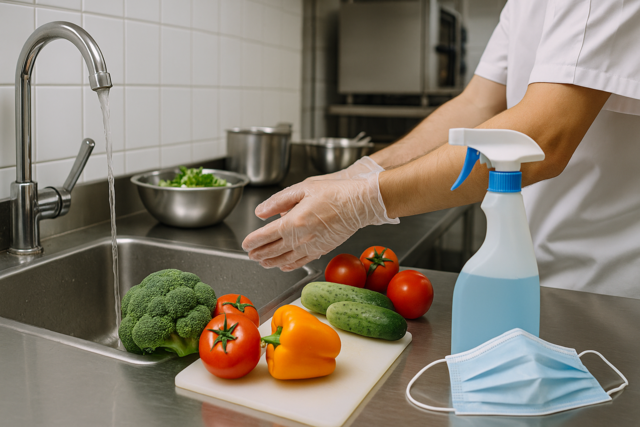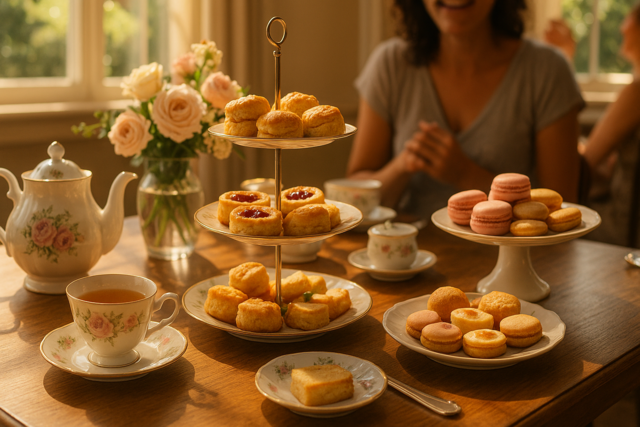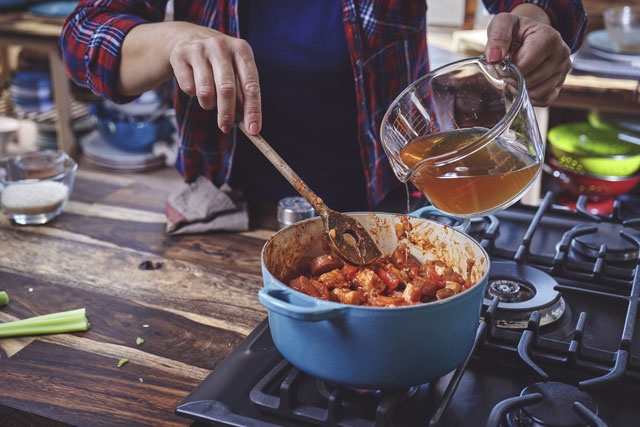Although it can be tempting to prepare 30 different types of snacks for your party, it will help keep costs down and simplify your preparation process if you select a handful of sweet and savory items, like two or three types of sandwiches, one type of quiche, one salad, and simple fruit and vegetable platters.
Finger sandwiches
The quintessential tea party food item is the finger sandwich, a term that simply means a sandwich cut into small enough pieces that you could easily pick it up with your fingers and eat it without making a mess. Plan three to four finger sandwiches per person if there is also a salad or substantial dish.
When assembling these little sandwiches, think about varieties in flavor and texture of the bread, as well as the fillings. A range of color makes the food more visually appealing and healthful. Most finger sandwiches are crust-less, but there is no universal rule that all crusts must be cut off before serving. In some cases, as with a croissant sandwich, that would be impossible.
A word to the wise: when selecting sandwich recipes, strive for variety. Don't pick three sandwiches that all include cream cheese, or two sandwiches that are both heavy on mayonnaise.
-
Cucumber sandwiches: Peel the skin off of fresh cucumbers and slice thin. Spread thin-sliced rye or a dark/light marble-rye bread with cream cheese. Arrange the cucumber slices on the cream cheese, close the sandwich and cut into quarters.
-
Options: Include slices of cold roasted red pepper or carrot shreds in the sandwich for color. Use a flavored cream-cheese spread.
-
Tortilla pinwheels: Use large, burrito-sized tortillas or other flatbreads. Spread with refried beans (smooth, mashed and flavored beans), salsa, roasted red pepper, cheddar or pepper jack cheese, and romaine lettuce. Roll the tortillas up, jellyroll style, attempting to keep them in a roll, not a flat accordion shape. Cut the long roll into one-inch sections.
-
Options: Try different-colored tortilla shells (whole wheat, tomato, and spinach). Add deli-sliced chicken or turkey. Spread a layer of sour cream over the beans. Add fresh, chopped cilantro, chopped sun-dried tomatoes, or chopped kalamata olives before rolling.
-
Chicken-salad croissants: Mix up your favorite blend of chicken salad (usually a combination of mayonnaise, chicken, pickle relish and mustard) and spread on sliced croissant rolls garnished with lettuce or spinach leaves. Cut the sandwiches into bite-sized pieces.
-
Options: Try different types of fillings, like tuna, egg or ham salad. Branch out with different flavors, like curried chicken salad. Add fresh herbs like chopped chives or parsley to your mix for color.
Working ahead
Finger sandwiches can be assembled a day ahead of time, cut up, and stored in the refrigerator. To keep them from drying out, cover the sandwiches with a sheet of wax paper, and top that with a slightly damp paper towel and seal the container tightly.
Quiches
A quiche is a baked single-crust pie filled with savory custard that can be flavored in a nearly endless variety of ways. Quiches are wonderful for several reasons: they are relatively simple to make, you can put almost anything in one, and you can cook them a day ahead, store them in the refrigerator, and heat them up for serving.
You can always buy a quiche at the store, but they are so inexpensive to make that you may decide to give them a try.
Basic Rules of Quiche-Making
If you choose to make your own crust instead of buying a pre-baked crust, be sure to bake the crust before you add the filling. To keep the crust from puffing up in the oven, place a sheet of tin foil over the raw crust and cover the foil with about � cup of dry beans--the beans act as pie weights, and prevent air pockets.
As soon as you remove the cooked crust from the oven (it should still be pale, not brown) brush the bottom of the crust with egg yolk and allow the heat to cook the yolk, which will create a nice shield around the crust to keep it from getting soggy once you add the custard.
The eggy part of the quiche filling is a combination of egg and milk/cream. As a general rule, use about 3 to 4 whole eggs for every two cups of milk or cream. Using cream instead of milk will produce a richer, more custardy filling.
Be sure to pre-cook any vegetables or meats that you will be adding to the quiche. There are two reasons for this: the vegetables will shed water, which will alter the quiche filling. Also, neither meat nor vegetable will cook all the way through in the amount of time it takes the custard to set.
There is no need to re-cook cooked meats like canned, roasted or smoked salmon, ham, or leftover chicken. However, if you choose to use a fatty sausage like pepperoni, pre-cooking it will render off some of the fat before you use it in your finished dish.
Quiche ideas
Here are some popular quiche variations:
-
Quiche Lorraine: Traditional quiche Lorraine features cooked bacon, but modern variations also add Swiss cheese.
-
Tomato and goat cheese quiche
-
Spinach and mushroom quiche
-
Ham and cheese quiche
-
Roasted red pepper and smoked salmon quiche
Salads
You can keep your selection of fruits and vegetables as simple as an attractively arranged fruit and vegetable platter, or you can make a full green salad. There are limitless varieties of salad, but here are some ideas to get you started:
-
Asian mandarin salad: Chop a mix of spinach and iceberg lettuce. Add grated carrots, toasted slivered almonds, mandarin orange segments and slices of grilled chicken. Serve with an Asian sesame-soy dressing.
-
Greek salad: Chop romaine and iceberg lettuce leaves. Add feta cheese, chopped Kalamata olives and diced red onion. Serve with Greek vinaigrette.
-
Mexicali salad: Chop iceberg lettuce, top with roasted corn, cheddar or pepper jack cheese, diced avocado, sliced cherry tomatoes and thin-sliced grilled steak or chicken. Serve with salsa as a dressing.
-
Italian salad: Chop romaine lettuce leaves, top with marinated roasted red peppers, chopped marinated artichoke hearts, chopped olives, grated asiago cheese and drained, oil-packed tuna. Serve with Italian dressing.
-
Cobb salad: Chop Bibb lettuce, top with chopped watercress, diced avocado, cooked chicken, crumbled bacon, chopped hardboiled eggs, and blue cheese. Serve with a blue cheese dressing.
Sweet Menu Ideas
For cream teas or dessert teas for a small group, you need only select one or two options. For low tea, plan on at least two savory items and two desserts. Strive for a balance of flavors and textures: For example, plan on one chocolaty item and one fruity item, something smooth and something with crunch.
Scones
Scones are like the fancy cousin of a biscuit. They are usually made with more sugar, cream and butter. Some scone batters may also include eggs. It only takes about half an hour to mix and bake scones, and if you make your own, you have a limitless range of options: you can make your scones plain, or add dried fruit, candied ginger, candied lemon peel, or chocolate chips.
If you buy your scones, be sure to purchase them the same day of the tea party. Like biscuits, scones are never as good the second day.
Serve your scones with Devonshire cream (clotted cream) and an assortment of jellies that would blend well with the flavors in the scone.
Crumpets
Crumpets are the uncles of English muffin--some people think the English muffin actually resulted from a failed attempt to make crumpets. Crumpets are never split like English muffins are, and their spongy texture allows them to absorb butter very well. They are usually made from milk-based yeast dough, so you do have to allow rising time.
The batter can be poured free form onto a griddle (easier), but it looks better if you use very well greased round English-muffin rings or official crumpet rings. These will hold the dough into a perfect circle as it cooks, and keep it from spreading. After the first side is cooked, you flip the crumpet and gently brown the second side. The crumpets are usually served hot and buttered on the second side (which will be holey).
It takes about an hour and half from start to finish to make your own crumpets, but only about 30 minutes is actually hands-on work. The resulting product is far better than the aging, cold store-bought variety--It is even more pronounced than the difference between hot, homemade pancakes and the frozen type, because retail crumpets aren't usually frozen, but stored at room temperature for an unknown amount of time.
Butter is the preferred topping for hot crumpets, but they may also be served with jam or clotted cream.
Tea breads
Tea breads are sweet quick breads (meaning they are leavened with baking powder instead of yeast). Some familiar breads you can use at a tea party include banana, pumpkin, and zucchini bread. Strawberry and Blueberry-lemon tea breads are wonderful for spring and summer parties. These breads are simple to mix, and they take about an hour to cook. Many types of tea breads are readily available at grocery stores and bakeries.
Muffins
Muffins are basically individually sized tea breads. Mini-muffins are a great option for a tea party, where the focus is on small bites that you can easily handle while socializing.
Desserts
You could have an entire tea party based solely on dessert, with just an assortment of cookies to eat. We would recommend making sure your guests know it's a dessert party, so they don't show up hungry being forced to make a meal out of cupcakes. Some dessert options include:
-
Cookies
-
Cakes
-
Cupcakes
-
Pies
-
Mini fruit tartlets
To make it easier for your guests to pick up and eat the desserts while socializing, you will want to serve small pieces. You can also focus on individual-sized portions. Your neighborhood party store may sell small, disposable plastic cups (the size of a shot glass and clear). Guests love having their own tiny desserts like chocolate mousse layered with chocolate sponge cake served in these miniature containers along with miniature forks.
Preparing the food/planning ahead
Most of the foods mentioned here can be assembled ahead of time. If you are interested in doing as much work as possible before your party, here is a short example food preparation timeline:
-
One month ahead: Bake three varieties of cookies. Store in gallon-sized zip-top freezer bags in the freezer.
-
Three weeks ahead:
Select and buy your tea.
Start shopping for additional teapots, serving dishes, hot water urns, tea sets, cups or other service items.
-
Two weeks ahead: Bake two-dozen cupcakes, but do not frost. Store in gallon-sized zip-top freezer bags in the freezer.
Finish shopping for napkins, plates, cups, saucers and any other service items.
-
One week ahead: Decide what savory dishes you will be making and plan what you will need to buy.
-
Two days ahead: Purchase any food items you will be preparing yourself for the tea party. For example, buy the components of the tea sandwiches and salads you will be making.
If you will be hosting the event at your home, clean at least the areas of your home where guests are likely to go, like bathrooms, living room, and kitchen. Vacuum floors, dust, and wipe down countertops in addition to general tidying up.
Tidy up outdoor spaces.
If the party will mostly be outdoors, clean off outdoor furniture and make sure the space is visitor-ready.
-
One day ahead:
Assemble your tea sandwiches and store in the refrigerator.
Assemble your salads.
Prepare your quiches, if you are making any.
Remove frozen items from the freezer.
Frost the previously frozen cupcakes after they have thawed.
Prepare the venue. If you are hosting at your own home, arrange the space as you want it to be. You can set up the tables, put out the cups and saucers, and set the teapots where you intend them to go. Decide where coats, purses, etc. will be stored.
-
The day of:
Purchase prepared food items. For example, buy your store-bought scones, cakes, pies or cookies.
If using, bake your scones or crumpets the day of the party.
Prepare the venue. Arrange everything for the party. Arrange tables as you want them, put up any decorations you have, set out serving platters.
Prepare the non-tea drinks (lemonade, iced tea, etc.)
Arrange any food that does not require refrigeration on platters and set it in its intended location, covered with wrap.
Half an hour before guests are expected, begin heating the water for the tea. For a larger party, keep water in heated urns.
At party start time:
Greet guests
Begin brewing tea
Set out the prepared foods
Relax and enjoy your company

























